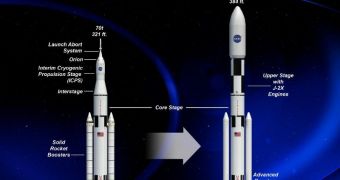Officials at the American space agency say that the Space Launch System (SLS) rocket passed an important review on Wednesday, July 25. This opens the way for experts to begin the preliminary design phase of the project. The SLS is scheduled to complete its maiden flight in 2017.
Developed as a means of transporting the Orion Multi-Purpose Crew Vehicle (MPCV) to near-Earth asteroids and Mars, the rocket will be produced in a variety of configurations, such as the 70-ton manned version and 130-tons cargo version.
Yesterday, SLS successfully passed the combined System Requirements Review and System Definition Review, meaning that the rocket can now move ahead in its design phase. It's primary purpose is to provide NASA with the capability of taking astronauts beyond low-Earth orbit.
A panel of NASA experts from multiple centers and areas of expertise analyzed the SLS documents describing vehicle specifications, budget and schedule, and decided that the project deserves the go-ahead. The concept development stage of the project is now officially over.
The SLS system architecture was determined to respect NASA demands. Additionally, the panel has found that the project is well integrated with the MPCV program and the launch facilities available at the Kennedy Space Center (KSC), in Florida.
It is also important to note here that the SLS managed to complete this important review just 10 months after the project began. The next stage in the rocket's development, the preliminary design review (PDR), is scheduled to be conducted near the end of 2013.
“This new heavy-lift launch vehicle will make it possible for explorers to reach beyond our current limits, to nearby asteroids, Mars and its moons, and to destinations even farther across our solar system,” William Gerstenmaier says.
The official holds an appointment as an associate administrator of the Human Exploration and Operations Mission Directorate, at NASA Headquarters, in Washington, DC.
“This is a pivotal moment for this program and for NASA. This has been a whirlwind experience from a design standpoint,” adds the SLS program manager, Todd May.
“Reaching this key development point in such a short period of time, while following the strict protocol and design standards set by NASA for human spaceflight is a testament to the team's commitment to delivering the nation's next heavy-lift launch vehicle,” he goes on to say.
While the SLS will conduct its maiden flight no early than 2017, the MPCV will be tested in 2013 or early 2014. The first joint mission is scheduled for 2020, and landing a human crew on a near-Earth asteroid is to occur by 2025. The next stage is landing humans on Mars, by the early 2030s.

 14 DAY TRIAL //
14 DAY TRIAL //